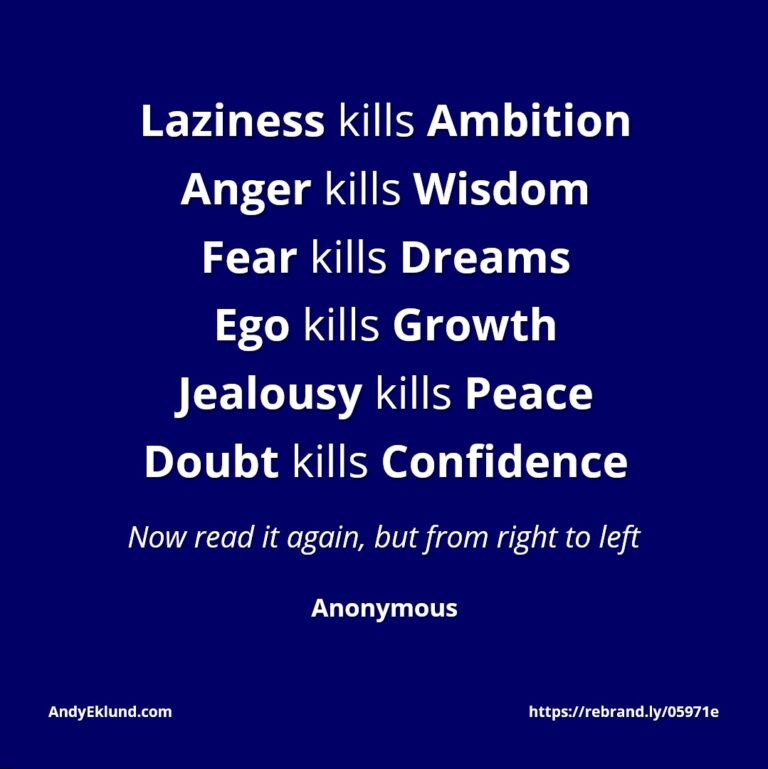Don’t Be Your Own Worst Creative Enemy is Post #8 in a series from a presentation entitled 11 Great Creative Slip-Ups: The Most Common Mistakes in Brainstorming. The introduction to the series begins here.
The Problem: We too often listen to our negative inner voice
Without any doubt, negativity is one of the most potent reasons why brainstorms fail.
A combustible mix of emotions and behaviours, negativity stops imaginative thinking in four ways:
- Pessimism – e.g., “That won’t work.”
- Adversarial – e.g., “Let me play devil’s advocate.”
- Arrogance + Dismissal – e.g., “We’ve already tried that.”
- Disdain – e.g., “That’s a stupid idea.”
However, this article isn’t necessarily about the destructive people around you in a brainstorm.
No, this ‘slip-up’ is more personal. It’s about you and being your own worst (creative) enemy.
I cannot count the times someone has told me after we finished the brainstorm they had an interesting idea, but were too afraid, embarrassed, shy or not confident to speak up.
When they told me their concept, more often than not, it was absolutely interesting. But it was too late to get other creative folk to make it even better. Imagine the confidence it would have given this person if others complemented them on their ideas.
But, as David Ogilvy famously said, “An idea not communicated effectively is like having no idea at all.”
When It’s Good, It’s Good. But When It’s Bad …
The little voice – also known as our inner voice, an internal monologue, or self-talk – is vital to our psychological existence. When the voice is positive, it guides us to better decisions and protects us from manipulation and hurt.
But it can just as easily be destructive. It not only tells us we, as a person, are not worth any value, but it extends that negativity to our creativity and the ideas we generate.
It’s not easy to turn off the little voice. For some people, it may be impossible.
I’m not a psychologist, but I do know this. You can learn to work with your negative self-talk.
The Solution: Don't be your own worst creative enemy
Here are four suggestions to consider.
1. Give the negative voice a name.
Recognize when you’re listening to your negative voice.
Dr. Marilyn Koch, a friend of mine who was a psychologist in Australia, suggested thinking of the negative voice as a gremlin.
“Give it a name,” she says. “When you start to hear your negativity speak to you, silence it by putting it in its place – ‘Oh, that’s just Archie talking.’”
By recognizing the negative inner voice for what it is or what it’s doing, it’s easier to be conscious of its effect on you. And, how to deal with this creative enemy, such as …
2. Ask the other voice what it thinks.
Self-talk has two voices, but we tend to only listen to the negative one.
What’s the other voice – the positive one – think? It’s easier to consciously silence and balance the negative voice by forcing yourself to also be complementary.
This is a great trick to use with ideas. Ok, so you have a bad idea. Ask yourself: Is there anything good about this idea?
Not all ideas are 100% bad. In fact, many times it’s usually one element of the idea that’s not usable. Ask yourself how it can be fixed, improved, adjusted or edited.
This is also good behaviour for a group brainstorm. When someone says an idea is bad, ask the group to identify the aspect(s) of the idea that may have relevance or merit, and encourage the group to improve it. Same with the bad aspects: what could be done to fix or adjust the idea to make it better?
3. Don’t ‘hatch and grade.’
When a farmer collects eggs hatched by their chickens, they don’t grade each egg on the spot. They have to gather all eggs together to be able to grade them consistently.
The same is true with brainstorming. Don’t hatch an idea and instantly grade it.
This hatching and grading at the same time slows you down, mentally jumping back and forth between divergent and convergent thinking. (It’s like criticising each word as you write them.)
If you’re constantly hatching, your corrosive voice begins to dissolve every idea to the point that you’re prematurely destroying every idea before you can objectively judge it.
In the end, you’ll kill all of your ideas.
Just get the ideas out. THEN judge them. It’s also easier, because you have context. (Remember, information without context is useless.)
4. Don’t forget that bad ideas die naturally at the end of every brainstorm.
A brainstorm agenda generally falls into an 80-20 split.
- 80% of the time is spent generating ideas.
- 20% percent is spent organizing, merging, combining, editing and sorting the messy ideas into a small group of ideas worthy of additional discussion, research and additional brainstorming.
Don’t expend energy during the 80% critiquing ideas. Focus instead on generating as many ideas as possible, knowing that soon you and your team will begin to edit and improve the lesser ideas into better ideas.
Any other tips or thoughts to help deal with your own worst creative enemy? Please add your thoughts and comments below.
If you want to return to the original article with links to the other ‘Slip-Ups’, click here.



No comment yet, add your voice below!